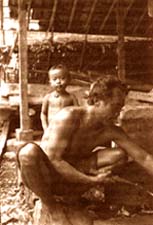THE PEOPLE
The Balinese are just one of Indonesia's 250 ethnic groups. Like most
Indonesians they are a blend of races, with the accent on the deutero-Malayan
race of Central and East Java, with traces of Polynesian and Melanesian
blood, as well as Indian and Chinese. This genetic background explains
the variety of racial types seen on the island. Most Balinese are small,
handsome people with round, delicate features, thick black hair, long sweeping
eyelashes, heart-shaped lips, and warm brown complexions, Others are darker-skinned
and straight-haired like Pacific islanders, or curly-haired with flat noses
like Papuans.
The Balinese are an extraordinarily creative
people with a highly sensual, theatrical culture. Their cults, customs,
and worship of god and nature are animist, their music warm-blooded, their
art as extravagant as their nature. By Western material standards most
Balinese are poor, though their poverty is masked by their exuberance,
their outdoor-oriented, picturesque ritual life, and their personal openness
and congeniality. Culturally, the Javanese lean more toward refinement
and modesty, keeping themselves in check in life and art, while the Balinese
prefer the headier, flashier sensations-laughs, terror, spicier and sweeter
foods. They're more lavish and baroque in their colors and decorations;
they like explosive music and fast, jerky dancing.
 Demographics
Demographics
The vast majority of the rural population practices the syncretic Bali-Hindu
religion, known officially as Agama Hindu or Hindu Dharma. There's also
a sprinkling of Muslims in the coastal towns, a Bugis settlement on Serangan
Island, Buddhists in the mountains, and Christians everywhere. Several
thousand Arabs and Indians, many shop owners dealing in textiles, gold,
silver, etc., live in Denpasar. Ten thousand Chinese are found in the main
trading centers of Denpasar, Singaraja, and Amlapura, running the majority
of the businesses. Relative to the rest of Indonesia, the number of Chinese
on Bali is very small.
There are also around 25,000 Western expatriates-clothes
designers, exporters, artists, aid workers, consultants, English teachers.
Many Western jewelry and garment makers have intermarried with the Balinese-it
seems every other fashion boutique or restaurant in Kuta and Legian has
an Italian or Australian somewhere in the family tree.
Population
Bali is a spectacular example of an island
favored by nature. Able to sustain a total population of 2.7 million, it
has easily the carrying capacity of neighboring Java. With a population
density of nearly 500 persons per square kilometer, Bali is Indonesia's
second most densely populated island after Java. In some of Bali's southern
districts the density is even higher, as much as 1,100 per square kilometer.
If the population density of the 48 contiguous United States were as great
as Bali's, the U.S.A. would boast 3.6 billion people.
Present estimates are that Bali's population
will increase to 4.5 million by the year 2000. The Indonesian government's
answer to mounting population pressure is to move tens of thousands of
Balinese to the Outer Islands in massive transmigrasi programs.
Complete Balinese communities-with temples, banjar, and subak-now
exist in Kalimantan, Sulawesi, and Sumatra. In addition, Bali's modern
family-planning practices, implemented through 150 clinics in villages
and hamlets all over the island, have resulted in the "Miracle of
Bali"-a birth rate down from 2.3% in 1970 to 1.6% today. Road posters
everywhere encourage families to produce only two children. Under the slogan
"Catur Warga" ("Four Citizens"), posters show a smiling,
well-fed, and transparently well-off family of mother, father, and two
children, obviously thoroughly convinced of the advantages of family planning.
The Bali Aga
As you climb into upland Bali the people
become harder looking, their faces less expressive, less likely to smile,
reflecting the harshness of their lives. On Bali there's still a distinction
between the Wong Majapahit, descendants of 16th-century migrants of East
Java's fallen Majapahit Empire, and the Bali Aga, the original inhabitants
of the island who retreated into the mountains where they're found to this
day, indifferent to outsiders. The Bali Aga never came under the religious
and despotic influence of the Javanese nobility, and thus still reflect
the true, republican nature of original Balinese society. In their reclusive
communities they constitute a nation within a nation.
As a people, the Bali Aga are woefully understudied,
their archaic dialect dying, many of their rituals abandoned. They are
known for their great austere temples-striking examples in Taro and Trunyan-and
the peculiar social divisions of their communities.
There has long been an unfavorable social
stigma attached to the Bali Aga; they're looked down upon by lowlanders.
But as time wears on, education, intermarriage, interdependent economies,
and the Indonesian language work to blur the distinctions between the Bali
Aga and Wong Majapahit Balinese.